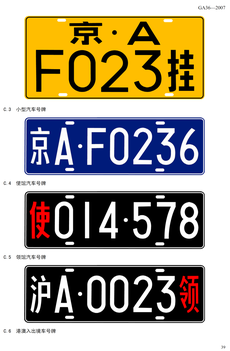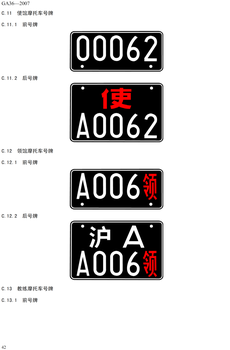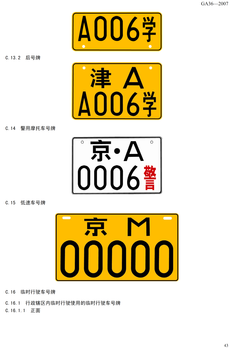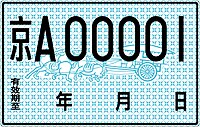|
Vehicle registration plates of China Vehicle registration plates in China are mandatory metal or plastic plates attached to motor vehicles in mainland China for official identification purposes. The plates are issued by the local traffic management offices, which are sub-branches of local public security bureaus, under the rules of the Ministry of Public Security. Hong Kong and Macau, both of which are special administrative regions of China, issue their own licence plates, a legacy of when they were under British and Portuguese administration. Vehicles from Hong Kong and Macau are required to apply for licence plates, usually from Guangdong province, to travel on roads in mainland China. Vehicles from mainland China have to apply for Hong Kong licence plates or Macau licence plates to enter those territories. The font used are in the Heiti (Traditional: 黑體, Simplified: 黑体) style. History1986-series plate In July 1986, the 1986-series Plates were put into use. The layout and format for them are listed out as follows:
Hong Kong and Macau vehicles are issued with plates for Shenzhen (广东02) and Zhuhai (广东03), respectively. Red-on-black plate-bearing vehicles are only allowed to drive within said cities. White-on-black vehicles are permitted to drive within Guangdong province, while if the vehicles are issued with green or violet plates according to their types, they have no area limitations. Public security vehicles (e.g. police) are issued with single-line plates with the format GARR-####, where the RR is the regional code, and the following numbers are the serial number, with the "GA" (abbreviation for 公安, gōng'ān, "Public security") in red. The regional codes are as follows:
Note: Chongqing was separated from Sichuan as a directly administered city in 1997, and the 1986-series standard was abolished in 1997 as well, therefore Public security vehicles in Chongqing bear the Sichuan code of GA51, instead of the later-introduced GA50. 1986-series plates are allowed to have the first number in the serial replaced by a letter with a special meaning, such as T for "taxi", Z for 自备车 (zìbèichē, "self-reserved vehicle"), G for 个体户 (gètǐhù, "entrepreneur"). Current Series typesCommon types
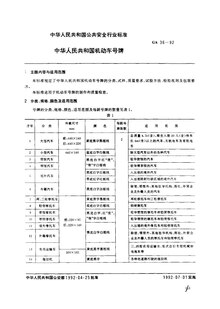   The current plates are of GA36-2014 standard, a further update of the original GA36-1992, made from GB/T 3880.1 and GB/T 3880.2-compliant aluminum material with a thickness of no less than 1.2mm (for rear plates for large vehicles and trailers) or 1.0mm (for any other non-temporary plates), or 200-220g dedicated watermarked paper with plastic sealing for automobiles and motorcycles entering the border on a temporary basis, or 125g white paper-card for temporary license plates. The plates accommodate a one-character provincial abbreviation, a letter of the Pinyin alphabet, and five numbers or letters of the alphabet (Ex. 沪A·12345; 京C·A1234; 苏A·1P234; 浙B·AB987; 粤Z·7C59港). Previously, all licence plates had used the five-number designation. As the number of motor vehicles grew, however, the number had to exceed what was the maximum previously allowable—90,000 or 100,000 vehicles. Therefore, there had become a need to insert Latin letters into the license plate to increase the number of possible combinations (for the full list of alphanumeric sequences permitted see below). This was first done in the bigger cities with only one prefix. Nanjing, for example, began the change with only the first number, which increased the number of possible combinations to 340,000 (with the exceptions of O & I, which cannot be printed without confusion with the numbers 0 & 1). Further changes allowed the first two places, or the second place alone on the plate to be letters, allowing 792,000 more combinations mathematically. More recently, cities have taken to having the third letter alone being a letter, the rest numbers.
Permitted alphanumeric combinations per GA36-2014 standard are listed in the table below. Should the number of combinations issued exceed 60% of the theoretical capacity of its type, the combination next in the list may be put into use after approval from the Vehicle Management Office of the provincial Public Security authority and reporting to the Vehicle Management Office of the Ministry of Public Security. Note: Y and N in this table reflects whether or not this combination type may be used in registration plates with 4 or 5 places for digits/numbers, while D and L represents any permitted digit or letter respectively.
The numbers are produced at random, and are computer-generated at the issuing office. Numbers with a sequence of 6s, 8s, or 9s are usually considered to be lucky, therefore special sequences like "88888" or "86888" can be purchased through auction.[1][2] A previous licence plate system, with a green background and the full name of the province in Chinese characters, actually had a sequential numbering order,[citation needed] and the numbering system was eventually beset with corruption.[3] License plates have different formats that are issued to different vehicles: Since October 2007, black plates are no longer issued for vehicles belonging to foreigners, as this was "deemed discriminatory" and instead standard looking blue plates are now issued. However, foreigners still are issued a separate dedicated letter/number sequence to denote that they are a foreign owned/registered vehicle—e.g. in Beijing, the foreign owned plates are in the 京A·#####, 京L·B####, and 京L·C#### sequence. The black plates are still issued to those who registered in both mainland China and Hong Kong or Macau, specifically in Guangdong province, which are in the sequence of 粤Z·####港/澳. Registration combinations of written-off vehicles may be "recycled", or used again on a different vehicle only after 6 months from the write-off according to relevant regulations, but as a matter of fact, certain serials of number like 京A·##### in Beijing is not available for general public once recycled for unspecified reasons.[citation needed] In 2015, a former Commissioner of Beijing Traffic Management Bureau, the traffic branch of Beijing Municipal Public Safety Bureau, was sentenced for life, having been found guilty of corruption relating to fraud in issuing these licence plate combinations.[4] Police Service, Armed Police Force, and Military
Licence plates for China's Police Service, Armed Police Force, and Military are in a white background, with red and black text. Police Service plates have a designated format of X·LLNNN警 (X is the geographical abbreviation, N is a digit, and L is either a digit or a letter; "警" means police and is coloured red, but the separator dot is no longer a circle, rather, a dash). These plates are issued to traffic police, some patrol vehicles, court, and procuratorate vehicles.  The plates’ combination of the Chinese People's Armed Police Force ("武警") begins with the pinyin wujing abbreviation WJ. The 2012 series of CAPF vehicle registration plates is in the WJ P NNNNL pattern, where the stands for a Chinese character i.e. 京 for Beijing, serving as the provincial identifier, and the L denotes the first letter in pinyin of the branch of service. e.g. WJ沪 1234X = a vehicle for firefighting use in Shanghai The 2004 series use the format WJNN-NNNNN.
Military vehicles previously had plates using a code of heavenly stems in red. After reorganization in 2004, again in 2013 military vehicles now use a more organized prefix. These licence plates use the format XL·NNNNN (X is a prefix, L is a letter). The People's Liberation Army vehicle prefixes 2013:
The People's Liberation Army vehicle prefixes 2004:
The Ground Force of PLA vehicle of the various military regions have their own prefixes:
The Navy of PLA vehicle prefixes:
The Air Force of PLA vehicle prefixes:
Vehicles with government or military plates are not subject to the Road Traffic Safety Law of the People's Republic of China (中华人民共和国道路交通安全法); they may run red lights, drive in the wrong direction or weave in and out of traffic.[5] Communist party officials and People's Liberation Army members are also exempt from paying road tolls and adhering to parking regulations.[6][7] According to Xinhua News Agency, "police officers are also reluctant to pull over drivers of military vehicles even if the drivers are breaking the law",[7][8] which is the reason behind an emerging trend in which individuals purchase counterfeit military registration plates to avoid being pulled over by police and to avoid road fees. Xinhua News Agency reported in 2008 that since July 2006, the government has confiscated over 4,000 fake military vehicles and 6,300 fake plates and has apprehended over 5,000 people belonging to criminal gangs; under Chinese law, those caught driving under fake registration plates are fined up to 2,000 RMB, and counterfeiters can be jailed for up to three years.[7][9] MotorcyclesMotorcycle licence plates are nearly the same as that for ordinary vehicles, but are less in length and look more like an elongated square than a banner-like rectangle. There are two lines of text (province code and letter on the top, numbers on the bottom). For qingqi or low-powered motorbikes, blue licence plates are issued throughout. Embassies and consulates Since 2017,[10][11] embassy and consulate vehicles have their own license plate with six white numbers followed by a single character denoting its diplomatic status, all on a black background (following the foreigner plate standard, as previously mentioned). Embassies use 使 (shǐ, from 使馆 meaning 'embassy') and are used only in Beijing. Consulates use 领 (lǐng, from 领事馆 meaning 'consulate') and are used for representations outside Beijing. Numbers on embassy plates are formatted so that the first three digits represent the foreign entity/organization the vehicle is registered to while the last three digits are sequential, where 001 is (generally) the Ambassador's car, for example: 224·001使 is the car used by the American Ambassador. Numbers 002 to 005 are usually reserved for official use and therefore enjoy the comfort of the highest levels of diplomatic immunity. In order to protect the privacy of foreign diplomats, the government does not release information on embassy vehicles, so it is possible that some data in the list of plate prefixes below may not be correct.
Other typesVehicles for use in automobile tests, vehicles for use in driving schools (examination and test-driving), and vehicles at airports all have their own separate licence plates. For automobile tests, licence plates consist of black characters on a yellow background with the suffix shi (试 short in Chinese for ce shi or test). For driving schools, different plates apply for test-drive vehicles (jiaolian che) and examination vehicles (kaoshi che). Airports have licence plates with white characters on a green background with the designation min hang (民航; 'Civilian Air Transportation'). This shade of green is slightly lighter than the variant used on normal licence plates prior to 1992. Some vehicles belonging to airports that operate in its vicinity (rather than inside its perimeters) have dark-green lettering on a white background. These plates, unlike others, permit the use of letter I (as in the SPIA-A00 series used in Shanghai Pudong International Airport) Sometimes, to avoid privacy invasion, modern Chinese TV show series are set in fictitious locations. Vehicles featured in these shows often carry registration plates with non-valid provincial abbreviations and/or invalid typefaces. Cross-border with Hong Kong and Macau Licence plates with a black background and the character 港 or 澳 in place of the last number are used for Hong Kong and Macau vehicles, respectively, when they engage in cross-border traffic to and from mainland China. These plates often exist side by side with a local Hong Kong or Macau licence plates on the same car. See the section on Guangdong license plates. Interim licence platesInterim licence plates are a piece of paper to be affixed to the front of the vehicle's window, usually valid for 15 days. Shortlived 2002 standard For a short while in the summer of 2002, a new 2002 standard was instituted in several cities, including Beijing. They enabled number/alphabetical customisation. (The possible combinations were NNN-NNN, NNN-LLL and LLL-NNN, where N would be a number and L a letter. However, although the usage of "CHN", to designate China, was not permitted in the plates, that restriction, oddly enough, did not apply to the letters "PRC".) The VIN was also added to the new plates, and the plates were white, with a gradual blue tint at the bottom end of the plates. Black letters were used on the plate. In late August 2002 new 2002 standard plates had their issuance temporarily interrupted, officially for technical reasons, but actually because some number/alphabetical combinations of a controversial nature in mainland China were utilised. One of the biggest controversies was when a vehicle with plate number USA-911 was spotted in Beijing, causing an uproar as it was taken to be a reference to the September 11 attacks, and as such was criticized as being disrespectful to Americans. Equal uproars were created with such plates as PRC-001, and trademark violations were rife; the plate number IBM-001 and was seen. The WTO acronym was also spotted in the plates. In a society that is still rather conservative in this topic, the plate SEX-001 was the source of yet another controversy. The number 250, an insult in spoken Chinese, was also spotted in some plates. Possibly due to the controversies as described above, as of summer 2003, the new plates are no longer being issued. Old plates of the 2002 standard are not being recalled. Cars who have lost their 2002-standard plates are disallowed to get a 2002-standard replacement. The 1992-standard plates will be issued instead. New 2007 Standard (GA36-2007)
 The Ministry of Public Security has announced on October 30, 2007, that the 1992 vehicle license plate system will be overhauled on November 1, 2007.
A minor difference between the 2007- and the 1992-standard plates is that the separator dot between the regional code and the serial on 2007-standard plates is embossed along the characters, while that on 1992-standard plates are pressed into the plate, in the opposite direction of the characters. Number plates issued in the 1992 standard will not be recalled but black plates will no longer be issued. Neither will plates issued to embassies be affected. It is believed this is a China-wide standard. Many provinces and municipal cities have since introduced personalized number plates with different limitations. It is generally possible to choose from several alphabetical-numerical combination and personalize some of the digits. For some provinces it is possible to have a letter occupying the last place of the combination, possibly to increase combination numbers. [12] New Energy vehicles license plates  On November 21, 2016, the MPS announced the New Energy vehicles license plates which have been instituted in Shanghai, Nanjing, Wuxi, Jinan, and Shenzhen since December 1, 2016. These plates consist of a one-character provincial abbreviation, a letter indicating the city, and a six-character alphanumerical string, in which "D" ("E") means Electric car, "F" means other types of vehicles powered by New Energy. For small vehicles or Large New Energy vehicles, this letter is located in the first place or the last place, respectively.[13] New Energy Vehicle License Plates are instituted in more than 10 cities as of 2017.[14]  Dimensions for the Chinese character remains at 45 × 90 mm as the 1992 standard, whereas numbers are reduced to thinner 43 × 90mm dimensions alongside a change in font, which is now found on 2019-standard registration plates for firetrucks as well. List of prefixesThe following lists all licence plate prefixes in use in the People's Republic of China, divided into four sections: municipalities, provinces, autonomous regions and others. MunicipalitiesBeijingThe initial character on licence plates issued in Beijing is: 京 (pinyin: Jīng)
ChongqingThe initial character on licence plates issued in Chongqing is: 渝 (Yú) The former division before May 18, 2017:
From May 18, 2017, Chongqing has no division for number plate prefixes, newly registed vehicles can choose any prefix among 渝A, 渝B, 渝C, 渝F, 渝G, 渝H from any district and county in Chongqing. ShanghaiThe initial character on licence plates issued in Shanghai is: 沪 (Hù)
For the third character of the license plates (with 4 digits following):
TianjinThe initial character on licence plates issued in Tianjin is: 津 (Jīn)
ProvincesAnhuiThe initial character on licence plates issued in Anhui is: 皖 (Wǎn)
FujianThe initial character on licence plates issued in Fujian is: 闽 (Mǐn)
GansuThe initial character on licence plates issued in Gansu is: 甘 (Gān)
Guangdong The initial character on licence plates issued in Guangdong is: 粤 (Yuè)
GuizhouThe initial character on licence plates issued in Guizhou is: 贵 (Guì)
HainanThe initial character on licence plates issued in Hainan is: 琼 (Qióng)
HebeiThe initial character on licence plates issued in Hebei is: 冀 (Jì)
HeilongjiangThe initial character on licence plates issued in Heilongjiang is: 黑 (Hēi)
HenanThe initial character on licence plates issued in Henan is: 豫 (Yù)
HubeiThe initial character on licence plates issued in Hubei is: 鄂 (È)
HunanThe initial character on licence plates issued in Hunan is: 湘 (Xiāng)
JiangsuThe initial character on licence plates issued in Jiangsu is: 苏 (Sū)
JiangxiThe initial character on licence plates issued in Jiangxi is: 赣 (Gàn)
JilinThe initial character on licence plates issued in Jilin is: 吉 (Jí)
LiaoningThe initial character on licence plates issued in Liaoning is: 辽 (Liáo)
QinghaiThe initial character on licence plates issued in Qinghai is: 青 (Qīng)
ShaanxiThe initial character on licence plates issued in Shaanxi is: 陕 (Shǎn)
ShandongThe initial character on licence plates issued in Shandong is: 鲁 (Lǔ) A "T" is further appended to taxis, for example "鲁B T1234", "鲁E T1234", "鲁Q T1234".
ShanxiThe initial character on licence plates issued in Shanxi is: 晋 (Jìn)
SichuanThe initial character on licence plates issued in Sichuan is: 川 (Chuān)
YunnanThe initial character on licence plates issued in Yunnan is: 云 (Yún)
ZhejiangThe initial character on licence plates issued in Zhejiang is: 浙 (Zhè)
Autonomous regionsGuangxiThe initial character on licence plates issued in Guangxi is: 桂 (Guì)
Inner MongoliaThe initial character on licence plates issued in Inner Mongolia is: 蒙 (Měng)
NingxiaThe initial character on licence plates issued in Ningxia is: 宁 (Níng)
Xizang/Tibet Autonomous RegionInitial character of licence plates used in Xizang/Tibet Autonomous Region is: 藏 (Zàng) XinjiangThe initial character on licence plates issued in Xinjiang is: 新 (Xīn)
See also
References
External links
|



